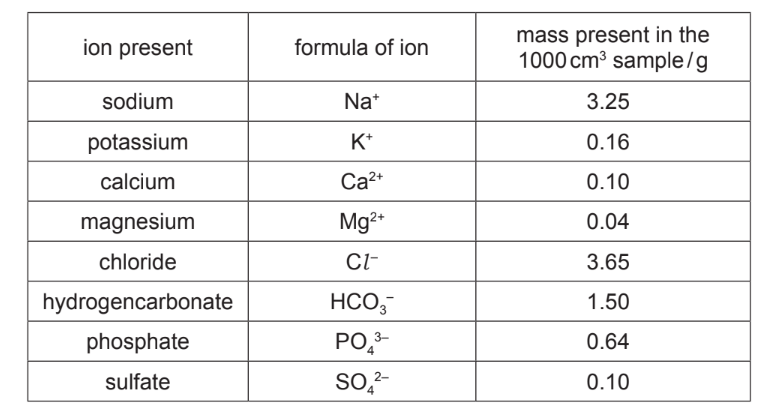Question
This question is about sulfur, sulfur compounds and the water from a sulfur spring. A sulfur spring is a natural source of water containing sulfur.
(a) The table shows the mass of ions present in a 1000cm3 sample of water from a sulfur spring.

Answer these questions using only information from the table.
(i) Which negative ion is present in the lowest concentration?[1]
(ii) Give the name of the compound formed from only K+ and Br– ions.[1]
(iii) Calculate the mass of calcium ions present in a 250cm3 sample of this water.
mass of calcium ions = mg [1]
(iv) Complete the equation to show the formation of a fluoride ion from a fluorine atom.[1]
F + ____ → F–
(b) Describe a test for sulfate ions.[2]
test
observations
(c) Solid sulfur is found around the edge of sulfur springs.
(i) When heated, sulfur undergoes sublimation.
What is meant by the term sublimation?[1]
(ii) Sulfur reacts with hot concentrated sulfuric acid.
Complete the chemical equation for this reaction.
S + ___ H2SO4 2H2O + ___ SO2 [2]
(iii) The table shows the solubility of sulfur and zinc in an organic solvent and in water. The organic solvent boils at 46°C.

Use the information in the table to suggest how to obtain pure, dry samples of both sulfur and zinc from a mixture of sulfur powder and zinc powder.[4]
(d) The structure of a sulfur compound is shown.

Deduce the molecular formula of this compound showing the number of sulfur, fluorine and oxygen atoms.[1][Total: 14]
Answer/Explanation
Ans:
(a)(i) Br– / bromide
(a)(ii) potassium bromide
(a)(iii) 11 (mg)
(a)(iv) e–
(b) (acidified and add aqueous) barium chloride / barium nitrate forms white precipitate (2)
if 2 marks not scored: 1 mark for barium chloride / barium nitrate
(c)(i) idea of solid turning (directly) to gas 1
(c)(ii) 2 (H2SO4) (1)
3 (SO2) (1)
(c)(iii)
- add (organic) solvent to the mixture (and stir until all sulfur dissolves) (1)
- filter off the zinc / filter off the residue (1)
- let solvent evaporate from zinc / residue (1)
- evaporate the sulfur solution / evaporate the solvent from the solution / evaporate solvent from filtrate (1)
(d) SF6O
Question
(a) The table shows the ions present in a \(1000~cm^3\) sample of blood plasma.

Answer these questions using only information from the table.
(i) Which positive ion is present in the lowest concentration?
……………………………………………………………………………………………………………………… [1]
(ii) Give the name of the compound formed from \(K^+\) and \(Cl^ –\) ions.
……………………………………………………………………………………………………………………… [1]
(iii) Calculate the mass of potassium ions present in 200cm\(^3\) of this blood plasma.
mass of potassium ions = ………………………… g [1]
(iv) When the \(1000~cm^3\) sample of blood plasma is crystallised, several compounds are formed.
Suggest the name of the compound which forms the greatest mass of crystals.
……………………………………………………………………………………………………………………… [1]
(b) Describe a test for potassium ions.
test ……………………………………………………………………………………………………………………………
result …………………………………………………………………………………………………………………………[2]
(c) Blood plasma also contains proteins. Proteins are present in food.
Which one of the following substances is also present in food?
Draw a circle around the correct answer.
carbohydrate hematite poly(ethene) terylene [1]
(d) Compound S is one of the monomer units used to make proteins. Its structure is shown.

(i) On the structure, draw a circle around the alcohol functional group. [1]
(ii) Deduce the molecular formula of compound S showing the number of carbon, hydrogen, oxygen and nitrogen atoms.
……………………………………………………………………………………………………………………… [1] [Total: 9]
Answer/Explanation
(a)(i)\( Mg^{2+}\) / magnesium
(a)(ii) potassium chloride
(a)(iii) 0.032 (g)
(a)(iv) sodium chloride
(b) flame test / description of flame test (1)
flame coloured lilac (1)
(c) carbohydrate 1
(d)(i) OH ringed 1
(d)(ii) \(C_3H_7NO_3\)
Question
Rhenium is a metal.
(a) Describe three physical properties of rhenium.
…………………………………………………………………………………………………………………………………………………………………………………………………………………………………………………………………….. ……………………………………………………………………………………………………………………………. [3]
(b) The structure of a rhenium chloride molecule is shown.

Determine the simplest formula for this chloride of rhenium.
……………………………………………………………………………………………………………………………. [1]
(c) Rhenium oxide is a yellow solid which undergoes sublimation at a low temperature. What is the meaning of the term sublimation?
……………………………………………………………………………………………………………………………. [1]
(d) Rhenium oxide reacts with water to form perrhenic acid. Perrhenic acid is strongly acidic.
(i) Which one of the following pH values represents an acidic solution? Draw a ring around the correct answer.
pH 2 pH 7 pH 9 pH 14
[1]
(ii) Perrhenic acid reacts with potassium hydroxide. Complete the word equation for this reaction.

(iii) Which one of the following compounds will react with perrhenic acid? Tick one box.

(e) Potassium perrhenate has a similar formula to potassium manganate(VII). Potassium manganate(VII) decomposes to give off oxygen. Describe a test for oxygen.
test ……………………………………………………………………………………………………………………………
result …………………………………………………………………………………………………………………………
[2]
[Total: 10]
Answer/Explanation
(a) any three from:
• silvery / shiny / lustrous
• conducts heat/ conducts electricity
• malleable
• ductile
• sonorous
• high melting point/ high boiling point
• strong/ hard
• high density
(b) \(ReCl_3\);
(c) change of state (directly) from solid to gas / gas to solid;
(d)(i) pH 2;
(d)(ii) water;
(d)(iii) potassium carbonate;
(e) glowing splint; relights / idea of bursting into flame;